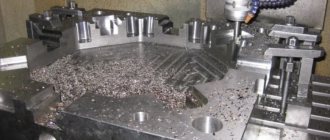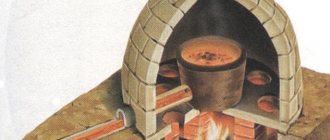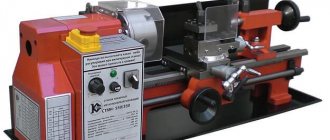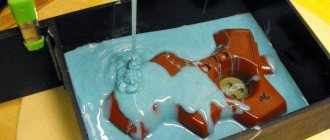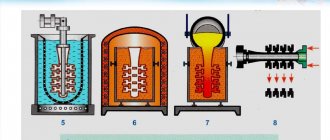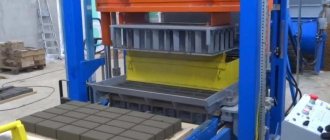Aluminum is a metal that is widely used in industry and everyday life.
It is used to produce not only aircraft and ship parts, but also dishes and other utensils. Therefore, there is often a need to independently manufacture aluminum parts that have failed.
The ability of aluminum to melt at relatively low temperatures makes it possible to produce cast products from it in artisanal conditions. In order to independently produce cast aluminum products, you need to know the behavior of this metal at high temperatures and its physical and chemical properties.
Characteristics of aluminum
The melting point of aluminum depends on the purity of the metal and is approximately 660 °C. Its boiling point is 2500 °C.
Aluminum is distinguished by its lightness and ductility, so it bends well and can be processed by stamping.
This metal is an excellent conductor of heat and actively enters into a chemical reaction at high temperatures with atmospheric oxygen, forming an oxide film on the surface. It protects aluminum from further oxidation, but when scrap melts, it significantly affects the composition of the alloy. During the metal smelting process, the structure of aluminum changes.
When it cools sharply, internal stresses and shrinkage of the resulting alloy may occur. This must be taken into account when working with aluminum at home.
Technologies for home aluminum casting and necessary equipment
The principle of casting aluminum at home should be based on the technology for its production in production, adjusted for conditions that can be used at home.
Aluminum products are produced by casting in several ways. In domestic conditions, the most common and convenient method is the technology of casting molten aluminum into specially made molds.
Therefore, to carry out the process, two things must be ensured:
- build a furnace for melting aluminum scrap;
- create the desired shape to produce a cast alloy or a separate part.
The casting process must include several stages:
- Preparation of aluminum scrap, including cleaning from dirt, impurities and various fillers, as well as grinding it to a small size.
- Carrying out the smelting process in the planned way. When the metal is completely melted, slag formations must be removed from its surface.
- Filling the prepared mold with liquid aluminum melt. After solidification, the ingot is freed from the molding mass.
Let's consider how to melt aluminum at home, what designs of furnaces for melting metal can be used, as well as options for making molds yourself.
Homemade furnaces and methods for melting aluminum
In order to melt aluminum, you need to heat it to a temperature close to 660 °C. It is impossible to reach such a temperature on an open flame of a fire. Therefore, a closed space is needed, which a homemade stove can provide. It can be heated by burning coal and wood or using natural gas.
You can also use an electric muffle furnace if you have one on the farm.
With a self-made stove, forced ventilation must be provided to maintain the combustion process.
1. The simplest version of a homemade fireplace can be made from old pots.
Its design is as follows:
- As a frame, use a steel container, for example, an old pan, on the side of which you need to make a hole to supply air through a connected metal pipe.
- Air can be forced through the hose using a vacuum cleaner.
- Coal is placed inside the device.
- Then the coal is set on fire and air is supplied to keep the fire from going out.
- A container for melting aluminum is first placed inside an improvised furnace structure and lined with coal on its sides. When it burns, uniform heat distribution is ensured.
- To prevent heat from being lost to the surrounding air, the top of the “pan” stove should be loosely covered with a lid, leaving a small gap for the smoke to escape.
An ideal design would be a firebox with an oval arch made from a masonry mixture used for heat-resistant bricks. You can use a flower pot of the desired size as a frame to create an oval vault.
After the mixture dries, a good firebox is obtained that can withstand several heats.
2. The second version of the furnace involves using the flame of a household gas burner to heat aluminum.
It can only be used for piece products made of aluminum weighing no more than 150 grams. An imitation oven is created by using two containers inserted into each other with a small gap. These can be ordinary cans from canned food.
The outer jar should be larger. A hole with a diameter of about 4 cm is made in it to ensure the supply of flame to the inner can.
The flame jet should be directed towards the opening of the can. Only the inner container is heated directly, and the outer one serves as a shell that retains heat. The top of the structure must be covered with a simulated lid, leaving a gap for the removal of combustion products.
Read also: Igbt transistors how to check
This design is disposable and can only be used for one melt, since the tin is thin and can quickly burn out.
Methods for creating a mold for casting aluminum
One of the main tasks of home aluminum smelting is preparing the mold into which the molten metal is poured. There are different options for pouring aluminum melt. The main ones are open and closed casting methods.
Open casting
The simplest is to pour the liquid metal into a handy form, such as a metal mug or can.
After the alloy has hardened, the blank is removed from the container. To facilitate this process, tapping is performed on the form that has not completely cooled down.
If you do not need to give the casting a clear shape, you can simply pour the liquid melt onto a prepared combustion-resistant surface.
Closed form
If it is necessary to obtain a complex casting, a mold is first made for it that meets all the parameters of the part. To ensure strict compliance of the product with the specified parameters, it is made from composite molding parts.
Centrifugal casting
Used in the production of products that have a rotational shape - bushings, gears, etc. Casting is carried out in a metal matrix rotating at high speed.
Centrifugal casting
Centrifugal force presses the liquid metal against the outer wall, where it crystallizes. The method allows obtaining extremely homogeneous castings. It is also possible to create multilayer parts. The layers are poured one after another.
Materials for casting molds
With the open pouring method, the simplest material that is always at hand is often used, this is silica. First, the earth is laid with layer-by-layer compaction. A casting model is placed between the layers, which, after careful compaction, leaves an imprint in the silica. This mold is carefully removed and aluminum is poured in its place.
Some craftsmen use river sand with the addition of liquid glass when preparing the base of the mold. A mixture of cement and brake fluid is also sometimes used.
Plaster molds
When making a model of a complex shape, gypsum is often used, which can mainly be used for a one-time casting process. When casting aluminum into a plaster mold, paraffin or foam plastic is used as models.
The wax model of the product is filled with plaster and, after drying it at high temperature, it is melted and drained through a special hole.
If the model is made from foam plastic, it is filled with gypsum mixture and left in it until the mold completely hardens. Hot aluminum melt is poured directly onto the foam. Due to the high temperature of the metal, the foam melts and evaporates, and its place is taken by an aluminum melt, taking the shape specified by the foam.
When using polystyrene foam as a model, work must be carried out in an open space or the room must be well ventilated, since the combustion products of polystyrene foam are harmful to humans.
Typical mistakes and tips for proper casting
- When working with plaster, you should avoid common mistakes. Despite the fact that plaster molds are a convenient way to cast the desired configurations of parts, this material is very sensitive to moisture. During normal air drying, it remains part of the gypsum. This is detrimental to the quality of the aluminum casting, as it can cause the formation of small shells and bubbles. Therefore, plaster molds need to dry for several days.
- The metal must be hot enough before pouring to fill the entire mold before it begins to harden. Therefore, after reaching the melting temperature, taking into account the rapid cooling of aluminum, there is no need to delay pouring it into the mold.
- It is not recommended to immerse the resulting casting in cold water to speed up the hardening process. This can disrupt the internal structure of the metal and lead to cracks.
As an option, I can suggest making a mold for pouring from plaster or alabaster.
Provided that your part is not of complex shape and does not have intricate reliefs or internal cavities.
We prepare a container slightly larger in size than your part, you can use any ready-made cardboard box or make it yourself from any cardboard or corrugated cardboard, you can half a plastic bottle, dishes, the main thing is to then remove the resulting form for filling.
Coat the part with technical Vaseline or other thick lubricant.
We prepare two dowels for centering the shape of two halves, for example, saw off two 2 cm pieces from a pencil, coat them with Vaseline.
We choose alabaster to make the mold.
We dilute alabaster as follows: add the required amount of alabaster to a container with cold water, wait until the water is completely absorbed into the powder and then stir until a homogeneous consistency is obtained.
The solution should look like medium thick sour cream.
A viscous solution is obtained from the proportion of 1 part alabaster to 1 part water.
Dilute such an amount of solution to use it in one go, since the mixture will harden quite quickly and will need to be thrown away; there is no point in restoring it; the properties of alabaster are not restored.
Pour enough solution into the container so that your part is immersed halfway in it. This will be half of your shape.
It is important to position the part so that after the solution hardens, it can be removed from this half of the mold.
Along the diagonal of the mold, separately from the part, vertically immerse two dowels halfway.
When the solution hardens, we will try to carefully remove the part and return it to its place. Everything worked out, let's continue.
We make a gasket for the frozen mold from available materials: plastic film, tracing paper, thin paper, close only the mold, do not close the part. You can also lubricate it with Vaseline.
We make a cylinder with a funnel on the edge from plasticine at the distance from the part to the edge of the mold and place it in the mold, this will be the filling channel. Decide on the thickness yourself.
Read also: Do-it-yourself potato hillers for a mini tractor
We dilute the required amount of solution and fill the part completely and wait for the second half of the mold to completely harden.
Then we remove the resulting form from the container, carefully separate it into two halves, take out the part and plasticine, and clean up the defects.
We connect the form, the funnel goes to the top, that’s it, you can pour aluminum.
After pouring and removing from the mold, it will be necessary to modify the poured part manually using sandpaper, needle files, a cutter, etc. to the size of the original.
For many, the term “foundry” is closely associated with back-breaking labor and specialized professional skills. In fact, casting a part from the required metal is possible for the most ordinary person without professional training at home. The process has its own subtleties, but it can be done at home with your own hands. Outwardly it resembles the production of lead weights for fishing. Features of the aluminum casting process are related to the technical characteristics of the material.
Making silicone molds
Silicone molds are presented in stores in a large assortment, and yet it is not always possible to choose the appropriate option. Many craftsmen prefer to prepare molds themselves in order to reduce costs and get the product they really need. You can create forms in different ways, including using silicone sealant.
Materials and tools
To make molds, you need to prepare the following devices and consumables:
- catalyst - 2.5 mg (white spirit solvent is suitable),
- good quality silicone sealant - 100 ml,
- acrylic paint - the required amount,
- glycerin - 10 drops,
- a plastic cup,
- spoon and pipette,
- container,
- sand,
- blank for mold,
- vegetable oil or soap,
- brush.
Mixing ingredients
First you need to combine all the liquid components together. Place sealant in a plastic cup, add glycerin and paint using a pipette. Mix the mixture well and add white spirit. Then mix the composition until it becomes homogeneous.
Mold casting
After combining all these components, a composition is obtained that is well suited for casting any shape. Adding a solvent allows you to reduce the rate of silicone hardening and have time to perform further necessary actions with it.
The order of subsequent work is as follows:
- take any container or other container without holes,
- place in a container a model of the future shape, which was previously sculpted from plaster, polymer clay, plasticine or other available means (usually they paste over a suitable product with such materials, then carefully remove the convex master model),
- fill the workpiece with sand to accurately calculate the amount of silicone solution required,
- pour sand, lubricate the master model with oil or soap, secure it in a container,
- apply silicone to the mold, carefully working out the smallest bends of the relief, let the material dry,
- after 5-10 minutes, fill in the remaining silicone,
- after 8-10 hours, detach the finished mold from the master model.
Using sealant - second method
There is another way to make molds from silicone, however, with its help they are less elegant, and small details are not always clearly visible. In its pure form, the sealant is quite sticky, so you need to add potato or corn starch to it. The proportions must be chosen so that the end result is a thick “dough”. The sealant should be placed in a disposable glass, adding starch little by little and preparing the mass.
After kneading the dough, you need to take a master model, grease it with cream or oil, then stick it with silicone. Leave the workpiece for a day, then detach it from the base. Another option is to press the master model into the dough ball, carefully align the edges, and after a couple of minutes remove the product.
How to cast aluminum
Characteristics of aluminum.
Aluminum is one of the most common metals.
It is silver-white in color and lends itself quite well to casting and machining. Due to its characteristics, aluminum is equipped with high thermal and electrical conductivity, and also has corrosion resistance.
Technical aluminum has a melting point of 658 degrees, high-purity aluminum has a melting point of 660, and the boiling point of aluminum is 2500 degrees.
For aluminum casting, home heating devices are unlikely to be useful and will provide the required temperature. It is necessary to melt aluminum by heating it to a temperature of over 660 degrees.
Aluminum casting: choosing a heat source
The following can be used as a heat source for aluminum melting:
- A very effective method is achieved using a self-made crucible muffle furnace. A crucible (a necessary tool for melting aluminum) is installed on the working surface of this furnace, and raw materials are added to it. Using a muffle furnace you can cast aluminum very easily.
- Do-it-yourself muffle furnace for melting aluminum, here!
- To obtain the melting temperature of aluminum, the combustion temperature of liquefied or natural gas is sufficient; in this case, the process can be performed in a homemade furnace.
- With a small volume of melting, you can use the heat obtained by burning gas in a household gas stove.
- The required temperature will be provided by gas cutters or acetylene generators, if available in the household.
Aluminum preparation
Despite the fact that the melting process will be performed at home, it must be handled responsibly. The metal must first be cleaned of dirt and crushed into small pieces. In this case, the melting process will go faster.
The choice is made on softer aluminum, as a purer material with fewer impurities. During melting, slag is removed from the liquid surface of the metal.
Sand casting
Several technologies are used to produce casting parts. The simplest is sand casting:
- If you need to make an aluminum part of a simple shape, then open casting can be done directly into the soil - silica. A small model is made from any material: wood, foam. Install in the flask. The soil is laid around in small layers and compacted thoroughly. Once the sample is removed, the silica holds its shape well and the casting is done directly into it.
- As a forming mixture, you can use sand combined with silicate glue, or cement mixed with brake fluid. The ratio of materials should be such that if the mixture is compressed, it retains its shape.
Video “Casting aluminum into an earthen (sand) mold at home”
For parts with complex shapes, a different technology is used.
Lost wax casting
This long-known method for making aluminum products at home can be slightly modified. The casting principle is as follows:
The model is made from low-melting material. It is placed in a certain shape and filled with plaster. One sprue or several are installed. After the plaster has hardened, it is dried well. At high temperatures, the low-melting material turns into a liquid state and flows out through the sprue. An aluminum billet is poured into the resulting mold.
The recommended material is wax, but it has one very big drawback. This is a high price for the material. But for small parts it will not cause much harm to the family budget.
Details of the process can be clarified in the video.
Video "High Pressure Aluminum Casting"
Thus, even the most ordinary amateur craftsman can make the necessary part from aluminum of various shapes.
Shell casting
To cast metals using this method, a composition is prepared from sand and a powdered binder, most often phenol-formaldehyde resins.
The model or mock-up is heated to 300 °C and sprinkled with the prepared mixture. In a short time (about a minute) a hardened layer is baked on the surface of the model. Excess mixture is removed.
Sometimes the clad mixture is blown into the gap between the heated model and the figured flask. The next stage is firing at a temperature of 650 °C for final strength gain. After removing the model, the halves of the matrix are connected together - and it is ready for casting. To prevent the matrix from being deformed by the weight of the melt entering it, it is surrounded by a metal box, which is filled with shot. The shot also improves the cooling schedule of the product.
Shell casting
Main advantages of the method:
- significant reduction in labor intensity and time for preparing the mold compared to casting in the ground
- control of the cooling mode of the product
- the process can be mechanized
This type of filling is suitable for products weighing up to 30 kg.
How to cast a complex-shaped part from aluminum
Industrial enterprises often use metal molds. Aluminum casting molds can be made from a variety of materials. Most often, gypsum is used. Gypsum can be purchased at any hardware store at any price acceptable to you. It is recommended to use sculptured or white plaster.
An excellent option is sculptural, which is marked G-16. Due to the high price, it can be replaced with G-7 - ordinary white plaster. It is strictly forbidden to replace it with alabaster, despite the fact that they are often interchangeable in construction work.
Let's look at a simple way to cast an aluminum part with your own hands at home.
To cast an aluminum part we need:
- melting vessel;
- scrap metal;
- melting mold.
Main stages of the process:
1. Prepare a vessel for melting (you can use a vessel from part of a steel pipe).
2. We make a mold for melting. If the part has a complex structure, then the shape may have several components.
Read also: Pictures for cutting with a jigsaw for beginners
In our version, the form will consist of two parts. First, think about how to simplify the part for convenience (we recommend strengthening the holes with tape).
The mold is very easy to make from sculpting plaster (do not use alabaster!). You can use plasticine.
3. Before pouring plaster, you should lubricate the container with oil so that the plaster cannot stick to the container.
4. Carefully pour the plaster, shaking the mold periodically to release the bubbles.
It is important to know:
The hardening process of plaster is quite fast, so be careful and try to install the model in plaster in time.
In addition, it is recommended to install an object (for example, a small stick) in the plaster, which will become a channel for pouring our part.
5. A primary layer is required for the upcoming filling.
Take a drill and make 4 small holes, treat the shape with oil. This is necessary to ensure that the finished mold parts lie as stable as possible during the casting process.
6. Fill the second layer.
7. After hardening occurs, you need to carefully remove the mold from the container and separate the halves.
8. Before casting, we treat the mold with soot to avoid sticking of liquid aluminum. The form must be dried. The natural drying process takes place all day long. It is advisable to dry the gypsum blank in the oven. Start at a temperature of 11 0 0 C - one hour and two hours at a temperature of 300 0 C. It is necessary to provide holes in the plaster for pouring aluminum and removing residual air.
This is how we melt aluminum.
9. Then we place the liquid metal in the mold and wait for it to cool completely.
As a result, we obtain the desired workpiece, then we grind it and make special holes.
Burnout casting: technology features
Manufacturing a part from aluminum using burn-out casting has its own characteristics, which will be discussed below. The work is performed in the following sequence:
- Foam plastic is used as a material for the model at home. Using cutting elements and glue, make a figure that resembles the required shape in outline.
- Prepare a container for making the model. You can use an old shoe box. Mix alabaster with water. Pour the mixture into the box. Place the foam model. Level it out. Give the material time to harden well. Due to the rapid hardening process of alabaster, perform the work at an accelerated pace.
- Remove the box. Heat the mold in the oven to dry the alabaster and remove any remaining moisture. Otherwise, all the water from the alabaster will enter the aluminum and turn into steam, which will lead to pores in the metal and aluminum splashing out of the mold during work.
- Melt the aluminum. Remove molten slag from the liquid surface. Pour the metal into the mold in place of the foam. Due to the high temperature, the latter will begin to burn out and aluminum will take its place.
- After the metal has cooled, break the mold and remove the resulting cast aluminum model. You can watch the process in more detail in the video.
Purpose of cast concrete, its advantages and disadvantages
Using poured concrete as a self-leveling mixture
Cast concrete is a building material classified as hydraulic. Its main difference from the usual one is the use of fine sand as a filler and the use of plasticizers, which gives the mixtures excellent fluidity and elasticity.
- The main binder is cement. Various plasticizers and modifiers are used as additives, thanks to which the finished concrete has low shrinkage, easily spreads over the surface and does not delaminate.
- Additives also allow moisture to remain in the composition longer, so surface adjustments can be completed over a longer period of time.
- On many resources you can see information that cast concrete does not need vibration compaction. This may be partly true, but not entirely. The fact is that air bubbles intensively form inside the mixture when mixing it, so vibration when making shapes of varying complexity, or rolling with a needle roller in the case of a self-leveling floor, is simply necessary.
- The final surface of cast concrete tolerates moisture much better (it penetrates its structure less well), thanks to which the material tolerates temperature changes well.
- Cast concrete is used not only for the manufacture of finishing floor coverings. This material is very popular among designers of all stripes for creating decorative figures of various sizes and complexity. Here is a small photo gallery showing such creations.
Safety precautions and workplace preparation
High-temperature work is characterized by harmful fumes and is accompanied by the release of smoke, so they must be performed in the open air or in a forced-ventilated area. A side-flow fan must be used.
The casting process is accompanied by splashes and flows of molten metal are possible. The workplace will need to be pre-covered with a sheet of metal. It is not recommended to carry out work in a residential area - it is unsafe for others.
Basic mistakes when casting aluminum
Before casting aluminum at home, pay attention to the main errors that are observed when performing work:
- When making plaster molds, it is necessary that all moisture evaporate during the drying process. Otherwise, when filling the mold, the water begins to evaporate, turns into steam and may remain inside the aluminum in the form of pores and shells.
- If the heating is insufficient or if the aluminum has time to cool before starting work, the metal will not fill the mold well and distant areas will remain hollow.
- Do not cool metal by immersion in liquid. In this case, the internal structure of the material is disrupted.
Injection molding
It differs from the traditional type of pouring in that the melt enters the mold not under the influence of gravity, but under the influence of excess pressure created in the casting chamber by gas pressure or a piston. The crucible with the melt, its heating system, molds and metal wire are placed in a sealed chamber and represent a single mechanized and automated complex.
Injection molding
When the required melt temperature is reached, a metal wire made of a refractory titanium alloy is lowered into the crucible, and air pressure is supplied to the chamber. Under its influence, the melt rises into the matrix and fills it. The automation maintains constant pressure in the chamber, since its volume increases as metal is consumed. Next, ventilation pumps pump out casting gases into the air purification system. In this type of casting, pouring is carried out both in disposable sand molds, including gasified models, and in multiple ones: molds, cement, graphite and asbestos. After filling the mold, the remaining metal flows from the metal pipe back into the crucible.
Advantages of the method
- High degree of automation of foundry operations
- Elimination of manual labor in hazardous conditions
- Environmental friendliness
- High metal utilization rate.
Flaws
- Equipment complexity
- The size of the casting is limited by the size of the sealed chamber.
This type is popular in non-ferrous metallurgy for large batches of small and medium-sized parts.


